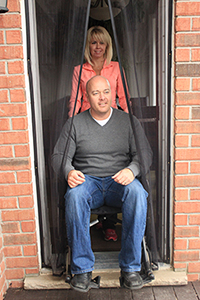Wheelchair Accessible Screen Door
Entrance doorways are not generally an issue for ambulatory people. But think about how a person using a wheelchair or walker manages to get through a doorway.
A conventional entrance to a house consists of a screen or storm door that opens outward, and a solid core exterior door which opens inward. An ambulatory person simply pulls open the screen door, reaches in to the exterior door, turns the doorknob, and pushes the door inward. For a person using a wheelchair the process is a bit more difficult.
The Wheelchair User
Entering a House:
The wheelchair user approaches the screen door gets close enough to unlatch it, assuming he has the dexterity, pulls the screen door towards him until it hits his wheelchair. He now must move his wheelchair backwards while holding the screen door to prevent it from shutting again. Now that the screen door is open the wheelchair user must propel his wheelchair forward towards the inner door with one hand while holding the screen door open with the other. Once he reaches the inner door again he must unlatch it, but this time shove it forward.
At this point he is using the side of his wheelchair to prop open the screen door and is trying to propel his wheelchair over a raised threshold that is common in exterior doorways. Even if there is a threshold ramp in place, he must propel uphill through the doorway while trying not to damage the screen door that is resting on his wheelchair.
Exiting a House:
When exiting a house the wheelchair user must unlatch the inner door, roll backwards pulling the door with him, roll forward past the open door to the screen door. He must then unlatch and push forward as he rolls through the doorway while pulling the inner door behind him to close it.
Both of the previous two paragraphs don’t consider the extra steps required if the inner, or screen door are locked. Also, as difficult as this process might seem, imagine doing it while it’s 20 degrees below zero, or it’s pouring rain, and the wind is howling.
Possible Solutions
- Remove the screen door. However, if the screen door is removed, the home owner loses the ability to leave the inner door open to allow fresh air through the house and natural lighting to enter. If they leave the inner door open without a screen door, their home quickly fills with mosquitoes, flies, and other flying insects.
 Knock down a portion of the door frame and install windows beside the inner door. Not only is this VERY expensive, but it also becomes a security threat. Burglars can easily break the windows and open the inner door to gain access to the house.
Knock down a portion of the door frame and install windows beside the inner door. Not only is this VERY expensive, but it also becomes a security threat. Burglars can easily break the windows and open the inner door to gain access to the house.- Pocket screen doors. Although not as expensive as installing windows, still not exactly cost-friendly. Not only that, but the installation of pocket doors is not simple, or cheap. It can be quite expensive to have a professional come out to install the pocket screen door.
- Install a magnetic screen door. Not only do these types of screen doors provide insect protection without blocking access to the house, but they are relatively inexpensive to buy, and are simple to install. You do not require a professional to come out to install one of these screen doors.
 Knowing from experience that traditional screen doors are difficult for people in wheelchairs to navigate around and through, the solution would have to meet several important criteria:
Knowing from experience that traditional screen doors are difficult for people in wheelchairs to navigate around and through, the solution would have to meet several important criteria:
- Had to be hands-free usability
- Had to be light enough to easily navigate from a wheelchair, yet durable and heavy enough to withstand constant use and moderate breezes
- Had to be attractive, yet functional
- Had to be wide enough to suit the often widened door frames of wheelchair accessible homes
The Sentry Magnetic Screen Door is the ideal solution for wheelchair accessibility. One large screen covers the whole doorway, providing excellent insect protection, natural ventilation, and solar shading for a more sustainable living environment.


